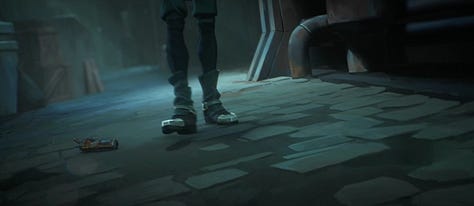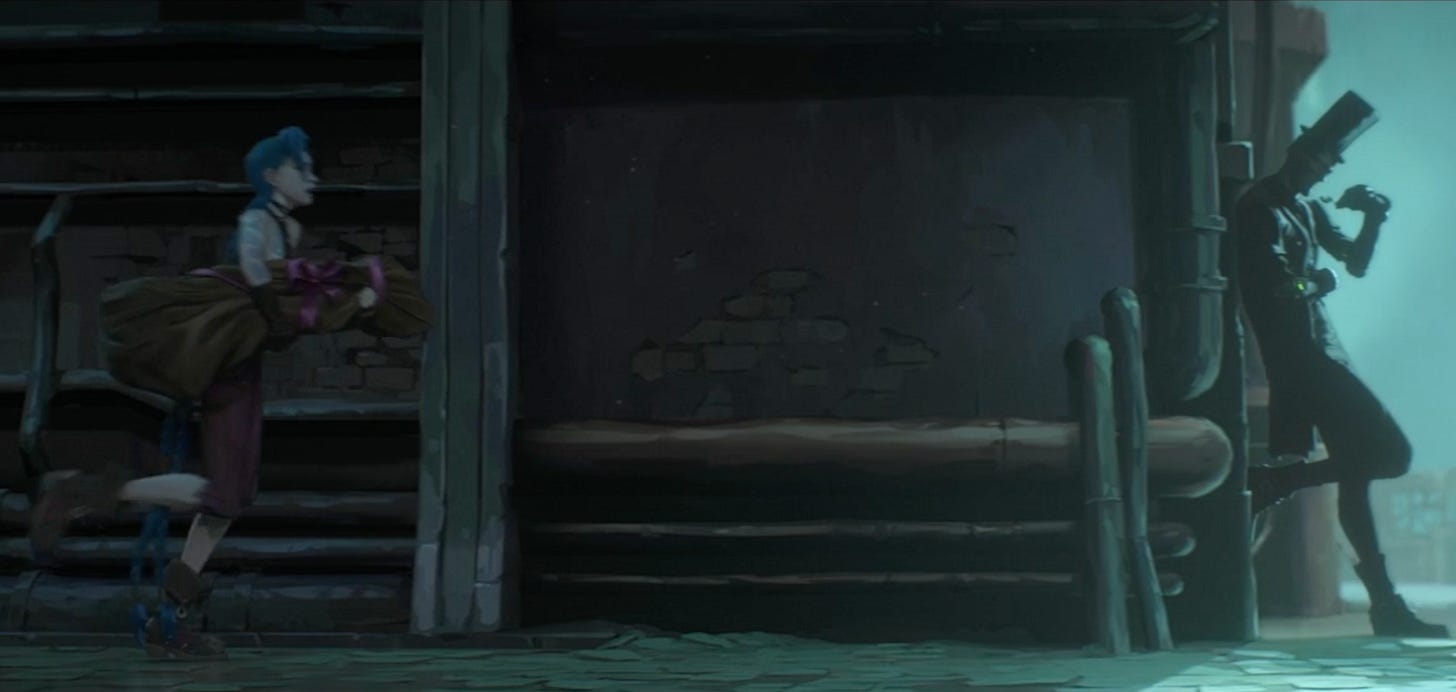Anatomy of an Ambush: ARCANE
Arcane 2.02 "Watch It All Burn" shows Jinx getting attacked by a strange, top-hatted man. Even as Jinx is taken by surprise, shots ensure the audience can follow events clearly — with plenty of flair to boot!
Let’s look at how this short sharp 24-second sequence: executes dramatic irony; plays with speed and time; and uses angles, editing, and match-cutting.
Dramatic Irony
We know something Jinx doesn’t know: there’s a man at the end of the alley. From what the scene shows us about Jinx, and because of how shots are framed, we also know Jinx doesn’t know he’s there.
The scene shows us Jinx facing left, crying, then turning and running Left-to-Right. As she runs, she stumbles and weaves, still crying, not clearly seeing where she’s going.
This shot makes it clear a man is outside the alley, just out of her eyeline:
And then!
Variable Speed and Time
The man bites into a skewered-onion(?)-and-tentacled-tidbit hors d'oeuvre [let’s go with oct-d’ouvre] and sends it flying.
As it flies we see a closeup of the oct-d’ouvre is in slo-mo (0:07-0:09), followed by a few fraction-of-a-second-long sped up shots of the man swinging at and hitting Jinx.
After Jinx is hit and begins to fall, everything slows again, giving that “life flashes before your eyes you know you’re about to hit the ground and have what feels like ages to consider what’s happening but can’t move fast enough to do anything about it” feeling.
All this happens in conjunction with tilted (and in the case of the fall, actively rotating) angles, clever editing, and match-cuts.
The pairing of shot angle and clip speed is important not just for contrast, but because it underscores whether we’re getting the experience of the ambusher or ambushee.
Angles and Editing
Angles and speed work in conjunction, and they’re carefully edited together to keep clear not only what is happening, but what characters are experiencing.
Before impact, when we’re in the angles of or ‘with’ the man who knows what’s happening, things move at regular or slow pace. When we’re ‘with’ Jinx — eg. seeing an arm come ‘out of nowhere’ to hit her, and then the reverse as the arm impacts her in a flash of white and neon green — everything is sped up.
Because the man lying in wait has time to think about and consider his actions, clips wholly within his wait are slo-mo. Because Jinx is surprised, clips are sped up and edited at a rapid pace, so we experience how sudden everything feels.






The edit lets us see what Jinx sees coming at her a split second before we see the impact, the punch’s effect demonstrated as a flash of white and neon fritz (as someone who’s been hit in the face plenty, I can attest it feels like this looks!), followed by a long, seemingly interminable fall . . .
Match Cuts
After Jinx’s fall slows and tilts, we return to the shot of the oct-d’ouvre from earlier, which is still airborn; another sign of how fast this all happened.
Except juuuust before it hits the ground, there’s a cut to a new angle of Jinx, who completes the fall the oct-d’ouvre primed us to expect.


Then Jinx turns, there’s a rack focus to her looking away from her attacker and seeing . . . another pair of feet.
A shadow falls over Jinx’s face, and here the dramatic irony ends: we know she’s surrounded, she knows, we know she knows, and the only possible outcome is more chaos.



Takeaways
It’s much easier to play with a few elements such as speedramping and 3-frame clips once the scene makes clear where characters are in relation to each other, and what all of the characters know / can see.
You can get away with a lot hyperstylisation, and even rapidly switching which characters’ experience the audience is within, so long as you take care to constantly orient your audience.



